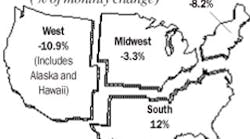Latest from Economic Data
New Data for Electrical Product Sales Estimates
Here’s some additional insight into the individual market segments covered in the 2014 McGraw-Hill Construction Forecast. This information was released in a McGraw-Hill press release late last month.
Single-family housing will grow 26% in dollars. McGraw-Hill said the positives for single-family housing are numerous — the pace of foreclosures has eased, home prices are rising, and mortgage rates remain near recent lows. However, the demand for housing will continue to be restrained by careful mortgage lending practices.
Multi-family housing will rise 11% in dollars and 9% in units. While growth continues, the percentage gains will be smaller than the previous four years, reflecting a maturing multi-family market. This structure type is still a favored investment target by the real estate finance community, which in the near term should lead to more high-rise residential buildings in major cities.
Commercial building will increase 17%, a slightly faster pace than the 15% gain estimated for 2013. Both warehouses and hotels will continue to lead the way, while stores and office buildings pick up the pace. The positives for commercial building are improving market fundamentals and more bank lending for commercial development. Next year’s activity in dollar terms will still be 28% below the 2007 peak.
Institutional building will edge up 2%, turning the corner after five years of decline. For the educational building category, colleges are revisiting capital expansion plans, and passage of recent construction bond measures in several states should help K-12 construction projects. Health-care construction is expected to remain flat, given continued emphasis on cost containment.
Electric utility construction will retreat 33%. This drop continues the 55% correction estimated for 2013 that followed the most recent spending high reached in 2012. Capacity utilization is down sharply, limiting the near term need for new generating capacity. The need for transmission line work remains strong.








